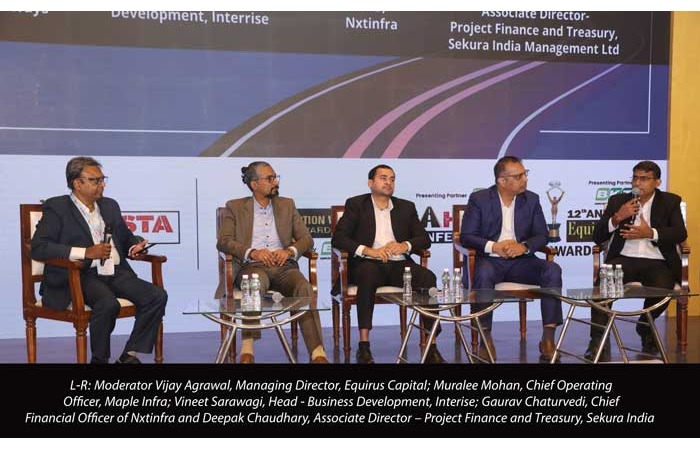
India’s Road Network Boom
In a remarkable achievement, the country has doubled its road network over the past decade, which has not only enhanced connectivity but also attracted substantial investments from infrastructure investment trusts (InvITs). “From the investor's perspective,” said Vijay Agarwal, Managing Director, Equirus Capital, “around 13 infrastructure investment trusts have been invested in road assets and nearly Rs 2 trillion is under investment.” Expressing optimism, Vijay highlighted that a majority of road assets are now housed under these InvITs, which have proven to be an efficient ownership structure that appeals to the market and investors alike.
Muraleemohan, Chief Operating Officer, Maple Infra, highlighted the growing international interest in Indian road assets emphasised, “the time to be in India is now,” especially in the roads sector. He noted that the government’s policies have created an unprecedented coexistence of multiple investor, developer and contractor classes within the highway industry, noting that the ecosystem offers equal opportunities to all players. “This is what excites international investors,” Muraleemohan added.
Road assets as an investment class?
Highlighting the robust infrastructure ecosystem in India, Muraleemohan called for greater recognition of different investor classes and their specific needs, noting that policy stability is critical for institutional investors looking to commit to Indian infrastructure projects.
“Highways provide tolling assets that give investors exposure to toll revenues, which are directly linked to the country’s nominal GDP. Toll rates are inflation-indexed, allowing access to traffic volumes that correlate with the GDP, making it a great way to tap into the fastest-growing large economy in the world,” said Vineet Sarawagi, Head – Business Development, Interise, praising India’s highway sector as an attractive investment destination, noting that it offers a diverse range of products for investors. Going further, Sarawagi suggested that to enhance the sector’s appeal, toll rates should be indexed not only to the Wholesale Price Index (WPI), but also to the Consumer Price Index (CPI). He argued that blending both indices could provide a more accurate reflection of inflation and boost investor confidence in upcoming build-operate-transfer (BOT) and TOT projects.
“Investors were hesitant to take on construction risk, which led to mixed experiences,” Gaurav Chaturvedi, CFO, Nxtinfra, said, emphasising that Infrastructure Investment Trusts (InvITs) have created a framework where different stakeholders could coexist more effectively. Breaking down the sector’s evolution, he described three distinct phases. "In the first phase, contractors took on the role of developers, primarily to feed their contracting arms and hold assets until maturity," he said. The second phase saw investors entering the market, but many were cautious about the construction risk involved. Now, in the third phase, all stakeholders have a clearer understanding of their roles, making this an ideal time for collaboration and growth. Chaturvedi concluded that this maturity in the sector presents a unique opportunity for stakeholders to engage in India’s infrastructure growth story with a balanced approach to risk and reward.
HAM and TOT: Easing investor risk
Pointing out how the hybrid annuity model (HAM) and toll-operate-transfer (TOT) frameworks have been instrumental in easing risk for international investors in India’s infrastructure sector, Deepak Chaudhary, Associate Director of Project Finance and Treasury, Sekura India Management noted that a significant portion of the risk in road projects lies in the construction phase, which many international investors are hesitant to take on. “For these investors, TOT has been the ideal solution, allowing them to focus on operational assets without construction risk.”
“Risk assessment is critical and relying solely on external consultants is not enough. In-house capabilities are essential for accurate risk analysis, he said emphasising the importance of having a strong in-house technical team to analyse and mitigate risks before entering any transaction.
Potential of GNSS for toll collection
“Over the last 30 years, electronic toll collection (ETC) has been a major positive disruptor, addressing issues like revenue leakage and skirmishes at toll plazas. With 99 percent of toll revenue now assured through technology, investors are only taking growth risks, not revenue collection risks," said Muraleemohan about the transformative impact of ETC systems. He noted that Global Navigation Satellite System (GNSS) and satellite-based tolling allows for precise tolling based on actual highway use, emphasising upon the confidence it brings to investors. He pointed out that GNSS requires significant infrastructure to detect vehicle entry and exit points on highways and suggested gantry-based tolling, which could eliminate the need for toll plazas entirely.


 +91-22-24193000
+91-22-24193000 Subscriber@ASAPPinfoGlobal.com
Subscriber@ASAPPinfoGlobal.com